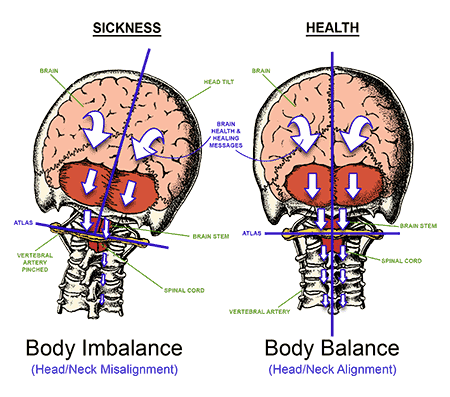What the Heck is Craniocervical Syndrome? And Why Does My Neck Matter So Much
So, you’ve probably never heard of craniocervical syndrome—but if you've ever had a whiplash injury, a bad bump on the head, or have been dealing with persistent neck pain and dizziness, this could be the culprit. Let’s break it down in a way that makes sense and, dare we say, makes your neck seem a lot more interesting than you thought!
We recently came across an article from August 2018 called, “Craniocervical Junction Syndrome: Anatomy of the Craniocervical and Atlantoaxial Junctions and the Effect of Misalignment on Cerebrospinal Fluid Flow.” That’s a mouthful, right? But the bottom line is that craniocervical syndrome happens when your upper neck (specifically the C1 and C2 vertebrae) gets knocked out of alignment, often after a car accident, sports injury, or some sort of trauma or repetitive stresss . And here’s the thing—when those bones (the atlas and axis) aren’t in the right spot, it causes all sorts of issues, including neck pain, headaches, dizziness, and even problems with how your brain communicates with the rest of your body.
Why Is My Neck So Important?
Let’s start with the basics. The upper two bones of your neck (C1 and C2) are super special. Unlike the rest of your spine, which has bony locks (the vertebrae) to hold it in place, these two neck bones are held in position by muscles, ligaments, and tendons. They’re the gatekeepers between your brain and the rest of your body. Think of them as the VIP bouncers at the club—if they’re misaligned, they can block the flow of information from your brain to your body, causing all kinds of chaos.
After an injury—say, a whiplash from a car accident—the muscles and ligaments in your neck might not be able to keep things in place like they usually do. This can lead to a misalignment at the C0-C1-C2 junction (yep, where the skull meets the neck), which messes with how the brain and body communicate. This "misalignment" is like putting a cork in the bottle of your body’s messaging system—leading to everything from headaches and neck pain to dizziness and tingling sensations.
Symptoms of Craniocervical Syndrome: Is This You?
Do any of these sound familiar?
Headaches or pressure in the head
Neck pain or stiffness
Dizziness or vertigo
Numbness or tingling in the head, neck, or arms
Fatigue, feeling off-balance, or difficulty concentrating
If you're nodding along (or know someone who is), it’s time to take a closer look at your upper neck alignment. Upper cervical chiropractic specialists are trained to assess and correct issues at the C1-C2 level without any twisting or popping. Just gentle, precise adjustments to get your neck back on track and help your body heal itself.
It Could Be Years Before You Notice
Here’s the kicker: Sometimes the effects of a misalignment don’t show up right away. You might feel fine after an accident or injury, but years later, you start noticing headaches, neck pain, dizziness, or even just a general sense that something’s “off.” We've heard countless stories of people saying, "I got rear-ended five years ago, and now I’m dealing with all these symptoms." Yup, that’s craniocervical syndrome slowly making itself known.
What’s an Upper Cervical Chiropractor Do About It?
Glad you asked! Upper cervical chiropractors are trained to gently correct misalignments in the C1 and C2 vertebrae without the twisting and popping you might associate with traditional chiropractic care. The best part? When these adjustments are done properly, they can hold for a long time—meaning fewer trips to the chiropractor and more long-term relief.
Think of it like this: when your C1 and C2 bones are in alignment, the body’s natural healing process kicks in, and the symptoms of craniocervical syndrome (like headaches and dizziness) start to improve. No need to keep adjusting your neck every week—it’s all about making that correction stick and letting your body do the rest!
The Bigger Picture: How a Misalignment Can Affect Your Brain Health
Now, this is where things get really interesting (and a bit alarming). Recent research suggests that a misalignment in the upper neck doesn’t just mess with your immediate symptoms like headaches or dizziness—it could also play a role in some pretty serious conditions like Alzheimer’s, Parkinson’s, Multiple Sclerosis, and other chronic neurodegenerative diseases.
Why? Well, the upper neck area is a major traffic hub for messages between the brain and the rest of your body. The vertebral arteries that run through the upper cervical spine carry 20% of the blood supply to your brain. If there’s misalignment at the C1-C2 level, it can restrict blood flow to the brain. Plus, it can mess with the cerebrospinal fluid (CSF) that helps keep your brain and spinal cord healthy. A kink in the flow of CSF is like traffic jams on a freeway—it creates back-ups and causes problems over time.
Bottom Line: Don’t Wait for the Pain to Get Worse
Craniocervical syndrome is a real issue that can start small but snowball over time. If you’re dealing with headaches, neck pain, dizziness, or any other symptoms we mentioned, it might be time to get checked out by an upper cervical chiropractor. These specialists can pinpoint any misalignment at the C0-C1-C2 junction and help restore balance to your body.
If you're tired of living with unexplained pain, dizziness, or those nagging symptoms, give us a call today! Let's figure out if craniocervical syndrome is what's holding you back from feeling your best.

